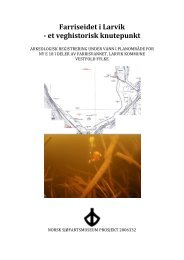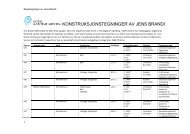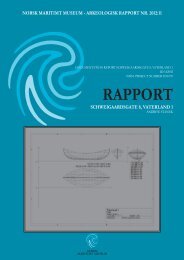Last ned 2009230_Rapport_Sørenga9_liten.pdf - Norsk Maritimt ...
Last ned 2009230_Rapport_Sørenga9_liten.pdf - Norsk Maritimt ...
Last ned 2009230_Rapport_Sørenga9_liten.pdf - Norsk Maritimt ...
Create successful ePaper yourself
Turn your PDF publications into a flip-book with our unique Google optimized e-Paper software.
The Anglo-Saxon Laboratory<br />
Bootham House, 61 Bootham, York YO30 7BT, United Kingdom<br />
www.aslab.co.uk tel: +44-1904-634585<br />
Report<br />
Samples of caulking material from Sørenga 8 and 9 and båtflak, Oslo,<br />
with an update on Sørenga 7<br />
On behalf of the <strong>Norsk</strong> <strong>Maritimt</strong> Museum<br />
Penelope Walton Rogers, The Anglo-Saxon Laboratory<br />
27 February 2012<br />
This report is concer<strong>ned</strong> with twelve samples of caulking material from ships’ timbers excavated<br />
in Oslo. Six are from Sørenga 8 (X030, X031, X034, X046, X055, X067), five from Sørenga 9<br />
(X0019, X020, X022, X032, X047) and one from a set of timbers labelled ‘båtflak’ (X008). Sørenga<br />
8 has been dated by dendrochronology to c AD1495 and Sørenga 9 to the winter of AD 1481-82,<br />
but the Sørenga båtflak timbers could not be dated by this means (Daly 2011). The material can<br />
be compared with other caulkage from Oslo, dated to the early 16 th century from Vaterland I<br />
(ASLab report 1 August 2011); to the mid and late 16th century from the Barcode ships (ASLab<br />
report 3 June 2011); and the 17th century from Sørenga 7 (ASLab report 28 September 2009). It<br />
can also be compared with a dated sequence of caulkage from Bryggen, Bergen (Schjølberg<br />
1984), and similar material from wrecks and quaysides in the British Isles (Walton Rogers 2005;<br />
Walton Rogers and Hall 2009).<br />
The samples were provided wet, pre-conservation. Their structure was recorded at x10<br />
magnification and then sub-samples were removed, clea<strong>ned</strong> in chloroform and exami<strong>ned</strong> and<br />
measured with a high-power optical microscope which allowed magnification up to x640 with<br />
transmitted light and up to x160 with incident light. All the material proved to be derived from<br />
animal coat fibres and their species was identified by reference to the standard fibre atlases<br />
(Wildman 1954; Appleyard 1978) and the author’s collection of modern specimens. Because<br />
species identification is a particularly difficult subject, to maintain standards, 10% of samples are<br />
routinely sent out to an independent laboratory for double-blind testing. In this instance,<br />
sample X046(a) from Sørenga 8 and the single sample of båtflak X008 were analysed at<br />
Microtex: the results replicated those produced at ASLab and confirmed the species<br />
identification in both cases.<br />
1








